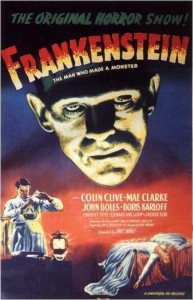 I have been feeling unwell all weekend. IT started with a sore throat on on friday that felt really bad on Saturday and by Sunday left me congested and coughing. Given all of that I knew I would not have the endurance for a full two hours or more picture, so I opted for an older and shorter film to watch, Frankenstein.
I have been feeling unwell all weekend. IT started with a sore throat on on friday that felt really bad on Saturday and by Sunday left me congested and coughing. Given all of that I knew I would not have the endurance for a full two hours or more picture, so I opted for an older and shorter film to watch, Frankenstein.
The 1931 production of Frankenstein is a very short film, just 70 minuets from start to end and while it deviates wildly from the original text, what can you expect when they can’t get the original author’s credit correct, it is still one of the best productions based upon that classic novel.
Of course you would have had to lived your life in a very deep and dark cultural hole to not know the basics of the story of Frankenstein. Dr. Frankenstein, in this production named Henry instead of Victor, obsessed with life and death, pursues dangerous and forbidden experiments seeking to create life in a body that has never known life. Robbing execution yards, universities, and graveyards for his materials Frankenstein allows no law and no morality to sway or hinder his experimentation. Aided by his hunchbacked lab assistant Fritz, nope not Igor, Ygor as it is spelled in Son of Frankenstein, doesn’t show up for a couple of films yet, Henry’s fiance Elizabeth, concerned by the strange and incomprehensible letters she has received from her groom-to-be enlisted the assistance of their best friend, Victor, who in the novel was named Henry, and together the Dr, Frankenstein’s former college mentor, they barge in just as Henry is ready to revivify — or should we vivify — the target body.
The centerpiece of any Frankenstein film is the animation sequences where the monster is brought to life. In the original novel Mary Shelly actually hand-waves her way right past this, leaving the reader with nearly zero images of the creation.
Here’s what Mary Shelly wrote for the creation event…
It was on a dreary night of November that I beheld the accomplishment of my toils. With an anxiety that almost amounted to agony, I collected the instruments of life around me, that I might infuse a spark of being into the lifeless thing that lay at my feet. It was already one in the morning; the rain pattered dismally against the panes, and my candle was nearly burnt out, when, by the glimmer of the half-extinguished light, I saw the dull yellow eye of the creature open; it breathed hard, and a convulsive motion agitated its limbs.
As you can see, very little detail. The James Whale 1931 Frankenstein animation sequence has become iconic, and every director who has followed has either patterned theirs against it, or drawn up sharply divergent imagery, such as the womblike creation depicted in Kenneth Branagh’s version.
An important distinct I think between Whales’s vision and all others that followed is just how quickly the 1931 films get to the creation scenes. Whales speeds us along with only just enough exposition to let us be informed of who and what is going on and then throws us full faced into the meat of the story. Other filmmakers have taken a more psychological approach, devoting great swaths of screentime to Frankenstein’s background and the causes and reasons for his obsession. This I think is a mistake. The story the plot that compels us to read and watch these same characters over and over are the events that follow the creation, not the ones leading up to it.
The creature, once created, is treated badly then kills and escapes. In the end Elizabeth is attacked by the monster and the villagers, torches aflame, hunt down the creature and burn it alive in a windmill.
The Frankenstein Monster, never named by Dr Frankenstein and referred to by Mary Shelly as Adam, is often viewed as a sympathetic creature, undeserving of its fate and hardly responsible for its actions. This is certainly the case with the James Whale 1931 Frankenstein. However, I do not think that this is the case with the original. When I read the original the creature struck me as sociopathic, as a being truly incapable of empathy. He claims he can love another, particularly a female made in his image, but those are just words. His action are of someone hurt and wrong lashing out at the world with pain and murder and death. If he has a choice he chose evil and if he has no choice then where does the sympathy lie? He would then be nothing but a beast.
Still, no matter how you see the monster, this film is worth seeing,

I’m pretty sure it was the 1831 as Victor and Elizabeth were not related by blood but by adoption.
Which version of the text did you read? 1818 or 1831, The emotional tone differs. Victor is more sympathetic in the later one, the relationship between Victor and Elizabeth is no longer incestual. The aspect that so many films omit or fail to handle well is the intelligence of the creature.